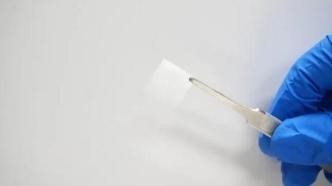
On the quartz plate, the corner rhombic boron nitride crystal with a thickness of only 1 to 3 microns is as thin as a cicada's wing, but its energy efficiency is 100 to 10,000 times higher than that of traditional optical crystals. This is the thinnest known optical crystal in the world invented by Chinese scientists. At the opening ceremony of the 2024 Zhongguancun Forum Annual Conference held on April 25, this crystal was released as a major achievement.
Optical crystals are the "heart" of laser technology. "Laser technology is the cornerstone of our current scientific and technological civilization, and it shines brightly in the fields of micro-nano processing, quantum light sources, and biological monitoring," said Liu Kaihui, a professor at the School of Physics at Peking University. Breakthroughs in laser technology are highly dependent on a special material - optical crystals.
Integration, miniaturization, and multifunctionality are the future development directions of lasers. However, it is difficult for traditional optical crystals to efficiently produce lasers within a limited thickness, so the preparation of thinner optical crystals has become the focus of research and development by scientists from all over the world.
After repeated attempts, Chinese scientists have identified lightweight boron nitride as the best choice. However, experiments have found that simply stacking boron nitride molecules layer by layer will cause "inconsistency" or phase mismatch when lasers pass through, which will hinder the efficient output of lasers and cannot be directly used as optical crystals in laser manufacturing.
Academician Wang Enge from the Center for Quantum Materials Science at the School of Physics at Peking University, Professor Liu Kaihui from the Institute of Condensed Matter Physics and Materials Physics, and Distinguished Associate Researcher Hong Hao, and other researchers have created a new crystal design method: by rotating each piece of rhombic boron nitride material at a specific angle like twisting a Rubik's Cube, the stacked optical crystal can reduce the energy consumption of the laser passing through and efficiently produce the required laser.
The combination of crystal design theory and preparation method pioneered by Chinese scientists has successfully reduced the thickness of optical crystals to 1 to 3 microns, while the thickness of traditional optical crystals is in the millimeter to centimeter range.
The research and development team summarized this method as the interface angle theory of two-dimensional materials. "The application of this theory is expected to reduce the size of lasers to the micrometer level. Some materials that were previously impossible to make optical crystals are also expected to be revitalized by rotating the material stacking angle," Liu Kaihui told reporters.